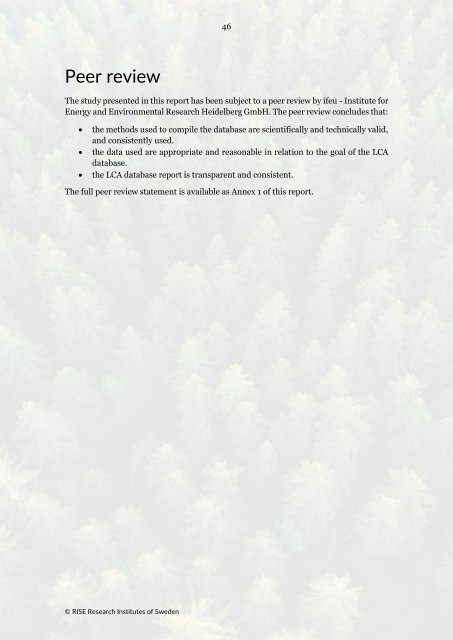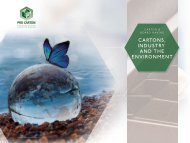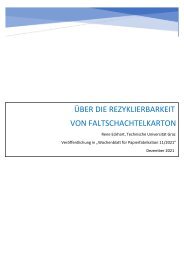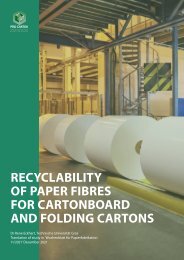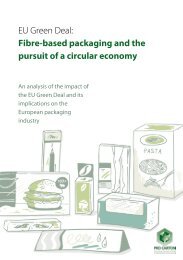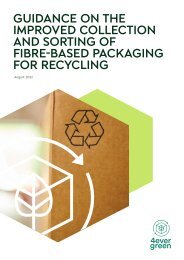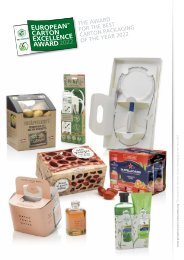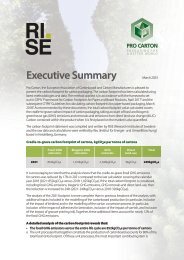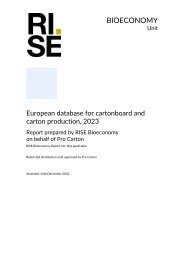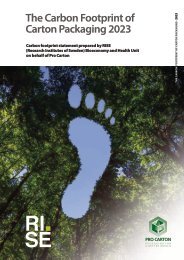European Database for Cartonboard and Carton Production 2023
You also want an ePaper? Increase the reach of your titles
YUMPU automatically turns print PDFs into web optimized ePapers that Google loves.
43<br />
surveys, it is no longer necessary to calculate net energy consumption at the mills <strong>and</strong>/or<br />
provide a credit <strong>for</strong> sold energy. This approach should result in a more consistent life<br />
cycle inventory which is easier to interpret<br />
• For purchased pulp, pulp nomenclature was clarified, resulting in consistent naming of<br />
different pulp types across the survey<br />
• For non-fibre inputs, data was requested on the dry mass percentage of the input to<br />
ensure that the consumption is always considered according to the active substance. Data<br />
was also requested regarding the transport distances <strong>and</strong> modes of transport <strong>for</strong> nonfibre<br />
inputs, resulting in a more complete underst<strong>and</strong>ing of transport associated with the<br />
raw materials consumed by the paper mills<br />
• For water consumption, inputs of sea/coastal waters were requested. Similarly, releases<br />
of water to sea/estuaries were requested. This in<strong>for</strong>mation may be important as the<br />
impact assessment categories <strong>for</strong> water develop<br />
• Further detail was requested regarding the management of residues arising from the<br />
paper mills. Previous experience with life cycle data providers has shown that<br />
assumptions regarding the management of some residues streams (particularly organic<br />
sludges, lime mud, green liquor dregs <strong>and</strong> calcium carbonate) can be very influential on<br />
the results achieved when using the gate-to-gate life cycle inventories to compile cradleto-gate<br />
life cycle inventories. In particular, assumptions that these residue streams are<br />
sent to l<strong>and</strong>fill <strong>and</strong>/or incineration can contribute significantly to the impact assessment<br />
results achieved. Collecting more detailed data relating to the management of residue<br />
streams has demonstrated that in fact the vast majority of residues arising at the paper<br />
mill are reused <strong>and</strong> recycled in some way.<br />
Trends in key environmental parameters<br />
The life cycle inventory presented in Table 2 represents the average <strong>European</strong> production<br />
of cartonboard <strong>and</strong> cartons, based on the data received during from mills <strong>and</strong> plants<br />
participating in the 2021 survey. As previously explained, the coverage of the market is<br />
noticeably increased <strong>for</strong> the 2021 survey compared to the 2018 survey. Whilst this means<br />
that the life cycle inventory presented in this version of the report is more representative<br />
of the weighted <strong>European</strong> average production, it also means that care should be taken<br />
when comparing this current inventory directly with previous versions of the dataset.<br />
If mills with large production capacity join the survey or drop out of the survey, then<br />
changes in the coverage of the papermills participating in the survey can be influential<br />
on the results achieved. This should be borne in mind when comparing the results of the<br />
2021 survey <strong>and</strong> the 2018 survey.<br />
Nonetheless, it is still valuable <strong>and</strong> in<strong>for</strong>mative to look at the trends in key environmental<br />
interventions over time. In particular, if we compare the 2018 survey <strong>and</strong> the 2021<br />
survey:<br />
• For the production of virgin cartonboard, total energy (purchased grid electricity plus<br />
external fuels plus internal fuels) required has been reduced by 14% in 2021 compared<br />
to 2018. For the production of recycled cartonboard, total energy has stayed relatively<br />
unchanged, with a 2% decrease observed.<br />
• This improvement in energy efficiency, combined with changes in the energy mix<br />
employed, has resulted in an 18% reduction in fossil carbon dioxide emissions arising at<br />
© RISE Research Institutes of Sweden


